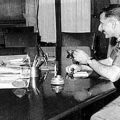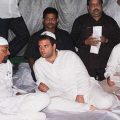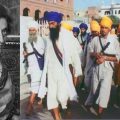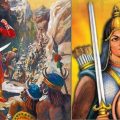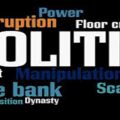Indira’s 1975 Emergency: How RSS Fought for Restoration of Democracy

The following is an excerpt from Ratan Sharda’s book RSS 360: Demystifying Rashtriya Swayamsevak Sangh. This piece is published with his permission.
Let me begin from the middle. The Emergency imposed by Mrs. Indira Gandhi on 25 June 1975 was a watershed event in the annals of independent India. It was also a defining moment for the RSS. It was an event which brought together all anti-Congress parties to a single platform, led to incarceration of various political leaders in common jails and gave them a chance to know each other better. At the end of it all, the Janata Party was born which brought down the curtains on this digression from our democratic traditions. The Emergency is a landmark event in the history of RSS too. People of my generation look at this struggle for restoration of democratic values as our signal contribution to the society. The current generations are unaware of a collective memory beyond the 1984 anti-Sikh riots and the 2002 Godhra train burning and subsequent riots in Gujarat. To them Emergency is a distant non-event. But, for the independent India, it was one of the most significant episodes in her modern history. I thought it would be a good idea to begin from this milestone in the life of RSS and our nation.
For the people of our generation, who were in the prime of their youth, Shri Jai Prakash Narayan’s (JP) movement for probity in public life had fired their imagination about `sampoorna kranti’ – total revolution – to throw out old decaying system and bring about a fundamental change in the political system. That it didn’t end up that way is a sad commentary on our political leadership and a deep sense of disappointment for us who dedicated their lives for the restoration of democracy, and fight for ideals personified by Jayprakash Narayan at that point in history. This pain is exacerbated further when we note that people like Lalu Prasad Yadav and Ram Vilas Paswan who have mocked at the ideals of JP by following a blatantly casteist and communal agenda to fulfill their political ambition are also the products of that struggle. The Hindu mythology of churning of oceans (saagar manthan) tells us that every churning that throws up nectar will also throw up poison. How true!
Let me not jump the gun and give a little idea about what this emergency was all about. After the heady days of 1971, with the decisive victory of India over Pakistan ending with liberation of Bangladesh, Mrs. Indira Gandhi and her courtiers raised her to a very superhuman pedestal. They presumed that they could do anything. This sense of arrogance, of absolute power was like an aphrodisiac for many Congress leaders who basked in the shadows of Mrs. Gandhi. Those were the days when the then Congress president Dev Kant Barooah declared that “India is Indira and Indira is India”. All this led to various acts of omission and commission. This arrogance went overboard with the persecution of opposition wherever possible. With power going to the heads of the ruling class, corruption became rampant.
First, Gujarat came into the grip of ‘Navnirmaan Andolan’ led primarily by students who wished to displace the highly corrupt regime of Chimanbhai Patel propped up by Congress. It was essentially a non-political movement spearheaded by students. As it picked force, RSS, ABVP members, erstwhile Jan Sangh and other opposition groups also supported the agitation actively which ultimately led to the downfall of Patel and installation of the first non-Congress government in Gujarat headed by Babubhai Patel. The agitation inspired a parallel agitation in Bihar too. Jayprakash Narayan or JP as he was fondly addressed, was persuaded to come out of virtual retirement and lead the agitation fueled by idealistic youth and students. A forum called Lok Sangharsh Samiti was formed and Nana Ji Deshmukh was nominated as the General Secretary of this forum which had members from the whole spectrum of political and student organizationsand few non-political social organizations. This was also the time when JP came very close to Jan Sangh and the RSS leaders seeing then great work on the ground. This intense ferment in the society shook up Congress and Mrs. Indira Gandhi. In interim her election was declared void by Justice Jagmohan Lal Sinha of Allahabad High Court which led to political chaos.
Mrs. Gandhi’s coterie played on her insecurity and convinced her on taking strong action to suppress this agitation and opposition. She declared a ‘state of emergency’ on the midnight of 25 June 1975, citing grave internal security threat to the nation. It was the first time that emergency was imposed citing internal security. A draconian act, the Maintenance of Internal Security Act (MISA) was revived to quell any dissidence, which allowed detention without trial for at least two years. All the important opposition leaders were arrested overnight and RSS was also banned for the second time since its existence. A few sundry organisations like Anand Marg and Jamat-e-Islami were also banned as tokenism to show that law was even-handed and there was no bias.
The Emergency pitch forked RSS into the battle for restoration of democracy. Just to give my readers an idea of RSS’s contribution to this fight, nearly 100,000 of the 130,000 people arrested during emergency were from RSS ranks. Of the 30,000 people arrested under the dreaded MISA something similar to anti-terror Maharashtra Control of Organised Crime Act, 1999 IMCOCAI, approximately 25000 were RSS activists. We realised during this time that other political parties like Socialists of different hues had more leaders than cadres, so it was very rare to see a socialist activist take part in the satyagrahas, though their leaders were arrested. Thousands of activists spent nearly 18 months under the MISA, or jailed for six months or more Under some IPC sections for staging satyagraha; while some like me spent a month or so before being released thanks to a historic decision by Justice Lalit of Nagpur High Court who declared that Emergency didn’t mean suspension of basic democratic rights. It is interesting to point out that Justice Lalit was virtually blacklisted and did not get his promotions later. This beginning of ‘committed judiciary’, as propounded by Mrs. Indira Gandhi, who was heavily influenced by a Communist coterie in those days led by late Mr. Kumarmangalam. The Communist Party of India (CPI) had supported her actions to ‘suppress and defeat forces of fascism’. It would also be appropriate to note at this juncture that the Communists had played a dubious role during the Quit India movement of 1942, and presented a petition to the Cabinet Mission of 1946 to divide India into 16 sovereign nations as it didn’t believe India comprised of 18 nationalities. They also justified the Chinese attack of 1962. The pro-Chinese section of Communists indirectly supported it by engineering a transport strike in West Bengal. Honourable comrades like Jyoti Basu were put behind bars for a short duration during this time. This section later split from the CPI and formed the CPI-M.
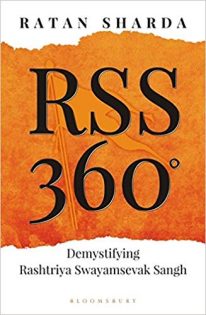
Click here to buy Ratan Sharda’s book RSS 360: Demystifying Rashtriya Swayamsevak Sangh.
RSS and its associate organisations’ leadership in consultation with other political parties, who were part of democratic struggle, instructed volunteers of all the associate organisations to organise satyagraha across the country to create awareness amongst people about atrocities committed in the name of saving India. This agitation was backed by RSS across the length and breadth of the country. Satyagrahis would appear in the most unlikely of places during public functions with high security cordons. Many of these acts of defiance were reported in international media too.
In a small place like my college, Parle College (today’s Sathaye College) in Mumbai, where I was the General Secretary of its student union and we had a very lively band of young RSS volunteers, we were able to sustain satyagraha for months and courted arrests nearly every week, much to the distress of the police. Our Principal Mr Potdar was so pained with the regular disturbance as also a college bandh following my arrest, that he threw me out of college like many students of my times. Eventually I ended up in St Xavier’s college under the benign guidance of late Professor Oza, a well known Marxist economist. For this same crime a fellow volunteer, my friend Girish Bodas, a student of IIT Mumbai, was put behind MISA on the grounds of a complaint filed by our college authorities. Incidentally, the whole Bodas family is a devoted Sangh family. While two brothers were in jail, their mother and father worked silently for their respective Sangh related organisations for women and teachers. Their only mode of communication in those days was leaving behind small notes on paper about their likely time of returning home. Such is the dedication of members of RSS and its associate organisations.
It is a telling commentary on the bias of so called scholars and of modern Indian history chroniclers like Ramchandra Guha that they simply gloss over these facts of history or write disparagingly about RSS contribution rather than highlight the exemplary way they bore the brunt of atrocities in and outside jail even as their careers, family lives and businesses were damaged or ruined.
Even RSS sympathisers and activists who were not active any more were picked up on the basis of Crime Investigation Department (CID) reports made years back. An illustrative case is the raid police made to search for my elder brother who had long since moved to Surat but his name appeared due to his activities a decade before. They didn’t search for my belongings though I was very active at that time. We used to hear of such humorous mix ups in many places.
We in Mumbai were a little lucky and police generally behaved decently with the agitators, realising that we were disciplined and law abiding. I suspect that police probably also understood the nature of the struggle and was sympathetic in many cases. Only if burdened with political pressure did they behave boorishly with volunteers. But, we listened and read about the indescribable horror stories of torture of RSS activists in police stations and jails, especially in states ruled by overzealous satraps of Congress like Punjab, Karnataka, Madhya Pradesh and Kerala (where both Congress and Communists hated RSS volunteers’ guts). But, the activists bore such insult and tortures resolutely. The tortures if described in detail would make the infamous Guantanamo Bay Detention Camp of US army look like a picnic!
Just to give an idea to this generation of how a supposedly democratic government and its bureaucracy behaves when it gets absolute powers, here’s a glimpse of the torture heaped on to these political prisoners, often including ladies. It is an example of how a fascist state can behave under the garb of democracy. Remember they were not hardened criminals. Their simplest punishment involved parading activists naked and keeping them so for days, strangling their dignity thus. They would force them to pee into each other’s mouths. They were also subjected to more sadistic treatment, that involved performing unnatural sexual acts in front of their colleagues and police, pushing rods, burning cigarettes into various orifices of human body. It could be plain torture by keeping a person thirsty for days on end, beating him or her, giving aeroplane treatment (tying hands behind back and letting the person hang from his hands for hours), pulling nails, and similar grotesque tortures. Most of these tortures are recorded by the victims and their colleagues while some are part of witness evidence in the Shah Commission appointed by the Janata Party government to enquire about the atrocities during the emergency.
It is alleged that the Congress government upon winning power in 1980, destroyed all copies of the report. But, it was resurrected with one copy that was found. Its hard cover copy was available on amazon.com, edited by late DMK leader Era Sezhiyan, but out of stock now. The working of this commission was disrupted by the party workers of the Youth Congress, led by Mrs. Indira Gandhi’s son Sanjay Gandhi. This is in itself is topic of contemporary history that students should study. These are the same elements who are top Congress leaders today and lecture RSS about rowdy behavior!
My narrative won’t be complete without mentioning the incarceration of George Fernandes who was put into jail in harsh conditions along with his brother Lawrence Fernandes and well known industrialist Viren Shah on charges of planning violence against the State. The case was famously known as the ‘Baroda Conspiracy Case’. These people were alleged to have conspired to use explosives to create terror down the government. Lawrence was so badly brutalised that he was a physical and mental wreck by the time he was out of the jail and died a sick man in 2005. George Fernandes was paraded around in chains and these photographs were published in national newspapers to scare potential rebels. This case was closed after the Janata Party came to power in 1977.
The press at that time behaved in a very tame manner except for some great exceptions like the brave owner of Indian Express GD Goenka and journalists like BG Varghese. The government had clamped censorship on the press on the very day the emergency was declared. Everything that were to be printed in newspapers had to be vetted by an omnipotent censor committee. The press brought up on license quota raj and newsprint doles behaved more timidly than required. Commenting on it, L K Advani had famously remarked, It crawled when it was asked to bend. We were thrilled and inspired by Mr Goenka, when he chose to keep the editorial column blank as he couldn’t write what he wanted to. The government then passed an order that you cannot keep a column blank. But, the Indian Express refused to crawl throughout the Emergency. It stood stoic against the volley of arm twisters initiated by the government. Goenka was harassed and indicted under various laws. Then, there was a famous classified in the Times of India which condoled the death of Democracy in a coded manner. The only way news could travel was through secret meetings, rumours, guarded telephone talks (even the telephones were tapped), people travelling around to carry news or undertake various activities. There were underground pamphlets which were distributed surreptitiously in thousands by the activists to spread news and informatation about the pro democracy agitation and government’s atrocities. Thew were grand courtiers of Mrs. Indira Gandhi like famed author our famous Sardar Khushwant Singh who wrote laudatory articles about great changes that the Emergency had brought about and how Sanjay Gandhi was a great visionary lender, a wonderful engineer with his ‘tin box’ of a small car. Mr Singh was suitably rewarded with citations, awards and lucrative postings. There were many such worthies in media who curried favours with Congress party during those days. To round off the car story I may mention that realising that the car was not going anywhere with its backyard technology; though the idea of a people’s car by itself was not bad; government finally adopted this project and in collaboration with Suzuki brought out the trail blazing Maruti car.
The press, including the great old lady of Boribunder, the Times of India, used to be awash with great stories about how the Emergency had improved work culture all around (which was a partial truth) and how people appreciated the great disciplined era (which was not that true) ushered in by the great leader Mrs. Indira Gandhi. All this was eerily close to the Russian propaganda mills. Any act beyond a point can become counter-productive and leads to excesses. Disapproval of such acts the Indira government to curb the the freedom of people was clearly demonstrated in subsequent election results. I am not expanding on these points as the focus of the book is not the Emergency but the role of RSS in the struggle for democratic rights.
On a personal and organisational front, this meeting of people from other political streams during the struggle and exposure to their ideologies was a great learning experience. There was a clear directive to work with all political and social organisations to fight the emergency. We used to meet every evening to play in open grounds but not in a regular way the shakhas worked. We would meet even in the nights to plan our strategies under the leadership of our local secretary for satyagraha and other modes of agitation, like putting up posters and wall paintings to register our protests.
Fortunately, I was also part of the team of volunteers who would ferry central RSS leaders to different locations incognito for one of the earliest meeting of central committee hosted for three days on three different venues within Mumbai that planned the agitation against emergency. It was funny to see these leaders in western dresses and wigs et al. Not being media figures helped a lot too. They used to stay with families as their uncles, and would be constantly on the move. A colleague of mine, Jagdish Baliga used to move in different attires and facial changes for months before he was finally caught. He was in charge of Dr Subramanian Swamy’s movements when he attended the Parliament and again disappeared to resurface in United Kingdom (UK). He was hosted in the UK by volunteers of Friends of India Society (FISI), a body floated to support pro-democracy movement in India. Among the founding members of FISI were members of Hindu Swayamsevak Sangh of U.K. a Hindu organisation registered in there. FISI played a prominent role in this struggle through out by lobbying for restoration of democratic rights in India and spread the true information about what was happening in India.
Big brother was watching everywhere, so there was a lot of thrill for us youngsters for underground work. The training we had received in shakhas since our childhood stood us in good stead. Not a single worker tried to stave off an imminent arrest for participation in satyagraha. Infact, it was the local leaders who would sometimes refuse to allow a person to take part in satyagraha because he knew the person had a serious problem at home or he was required for some other underground activity. It was simply another duty given by the Sangh and it had to be done, that was the attitude. For us, this was direct example of what could be achieved by praying to tbemotherland daily and pledging to serve her and the society unflinchingly and selflessly. This was also the time when lady members of sister organisations of RSS, mothers and sisters of RSS volunteers and young girl students also joined this struggle against dictatorship in good numbers. They also kept the morale of volunteers high by coming to courts during hearings carrying with them eatables and sweets.
The Emergency finally came to an end in 1977. One of the primary reasons for its end, was the political pressure that had built up on incarceration of over 100,000 political prisoners in jails. Protests, agitation and satyagraha had slowly gripped the country; coupled with the high number of political prisoners. This brought enormous pressure on Mrs Gandhi. Then, there was an international pressure built through various channels including the ones utilized by FISI. A critical factor was Mrs. Gandhi’s urge to legitimise her dictatorship by winning an election which many of her coterie thought would be a cake walk. “India is Indira and Indira is India” syndrome was in full flow. That the events proved her and others wrong reflects the strength of our Indian people wedded to democratic way of life for eons who went to polling booths with a determination that their leaders could not read.
We started off on a very low note when elections were declared, with instructions from the top to work whole heartedly for the victory of Janata Party. There were no resources and people feared coming out in the open even to the party offices initially. Polling booth level plans were devised. It is noteworthy that most of the senior and middle-level leaders were in jail at this time, and thus, we were leaderless going by the common political wisdom. The training in RSS shakhas was useful again. The young volunteers with the help of a few senior workers who were outside the jails soldiered on regardless of the possible outcome. We realised that an anti-emergency wave was building up only in the latter part of campaigning when people started thronging the election offices of the Janata Party. We got a shock of our life when an initial simple cycle rally turned into a strong rally of thousands without any major publicity. Even the local meetings would draw unprecedented crowds. It was a heady feeling. We went nuts when we heard the news of victory of pro-democracy forces in elections of 1977!
I would not like to digress detailing the dirty politics played especially by socialist groups within Janata Party to break it up under the guise of a manufactured controversy of ‘dual membership’ of ex-Jan Sangh members who had merged Jan Sangh into Janata Party. It was not that they were not aware this loyalty issue before the party was created. In fact, there are records of many such leaders singing paeans about RSS swayamsevaks for their role in restoration of democracy, their discipline and dedication. They had also gone on record saying that they had made a mistake in understanding RSS as they carried a bias within them for years. They had admitted that their close interaction with the RSS and Jan Sangh leaders had opened their eyes. The fact of the matter was that apart from the Communists and Jan Sangh no other political party had a structured organisation They used this organisational power till it suited them. Once they were in power they felt that this cadre might capture Janata Party if and when internal elections took place. They had also noted a sizeable chunk of MPs belonged to erstwhile Jan Sangh. Thus, followed the disgraceful game of back stabbing; split in the Janata Party; its downfall; and, the return of Mrs Gandhi.
Regardless of the final political outcome, for RSS it was an epoch making change-over. From an organisation limited to running shakhas and some social service projects and string of associate organisations like Akhil Bharatiya Vidyarthi Parishad, Vishwa Hindu Parishad, Bharatiya Mazdoor Sangh and others, it extended its reach in new areas. In fact, a major push for social service projects was made during this time as the volunteers had to find ways of working for society while RSS shakhas were shut down. This period proved Sangh’s mettle as a firm believer in democracy. Its acceptability reached new levels, and it grew rapidly after this, though RSS workers and workers of associated organizations had suffered hard during this period.
For us, the young volunteers of that time, it was a great learning period. Working underground, offering satyagraha in a virtual dictatorship being imprisoned were the learning blocks that we as the second generation RSS workers were introduced to, just as our predecessors were in 1948, following the ban on RSS. We learnt not just from each other, but from people outside the Sangh umbrella too. Opinions of others, including other political parties were of much value to us and we became well versed with the ideologies and working of electoral politics. Until this time our opponents would ridicule us, but after this phase RSS earned respectability and acceptability in socio-political field. Thus, it was a turning point for the organisation.
There is a small book in Hindi by RSS documenting history of RSS struggle for democracy. Unfortunately, it has not been widely distributed or publicised.
As politics has gotten pettier these days sullied with vendetta, it serves to remember that the then RSS Chief Shri Balasaheb Deoras had exhorted to the political class after 1977 Janata Party win to let bygones be bygones. He had advised against any sort of witch hunt against political opponents, including Mrs Gandhi. This was typical of RSS as it believes in all round growth of the nation, animosity towards none and wellbeing of all.
Featured image courtesy: Google.

